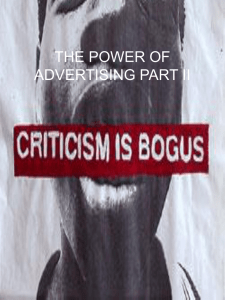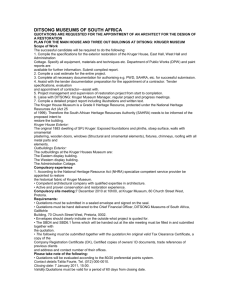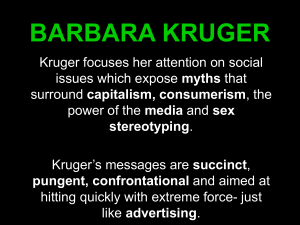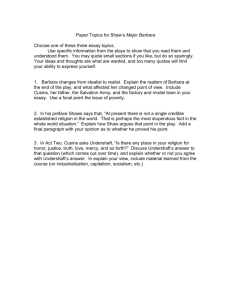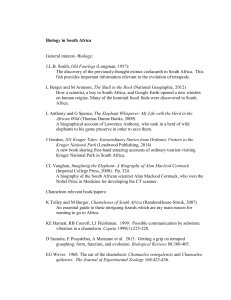We Will Not Become What We Mean to You
advertisement
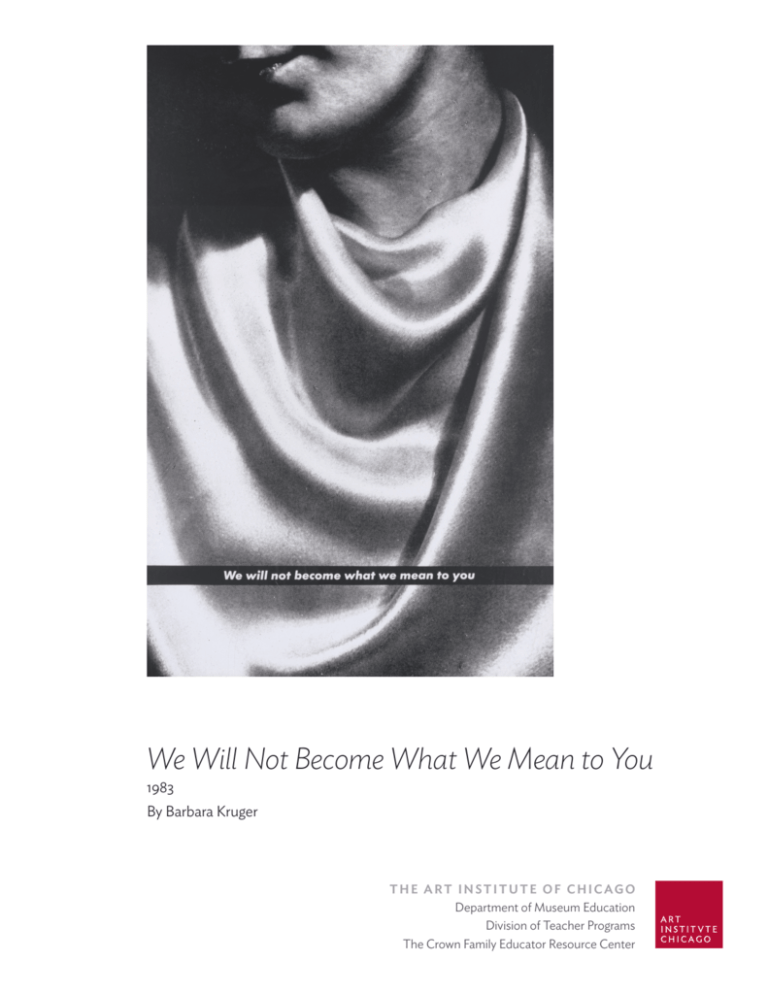
We Will Not Become What We Mean to You 1983 By Barbara Kruger T h e A r t I n s tit u t e o f C h ica g o Department of Museum Education Division of Teacher Programs The Crown Family Educator Resource Center Barbara Kruger, American, born 1945 We Will Not Become What We Mean to You, 1983 Gelatin silver print 121 x 184 x 5 cm (48 x 72 1/2 x 2 in.) Gift of Susan and Lewis Manilow, 2004.758 Barbara Kruger is known for works that provocatively integrate photographs and text. Her art reveals and challenges the ways in which images used in the commercial media often perpetuate stereotypes, objectify women, and encourage conformity. Informed by her earlier profession as a graphic designer—Kruger was employed for a time at Mademoiselle magazine—her imagery draws from American films of the 1940s and 50s, television, and advertisements. To her images she adds her own blunt slogans that challenge how the viewer might otherwise interpret the pictures. Because she alters images taken from other sources, her work is sometimes referred to as appropriation art. Kruger began combining image and text in the late 1970s after experimenting with poetry and fiber art. Although she practiced photography, she largely abandoned taking her own pictures in favor of using stock photographs and magazine illustrations. The images Kruger appropriates are consistently black-andwhite rather than color and provocatively cropped. Their style and subject matter suggest the clichés about American family life and the roles of men and women in society that circulated in the popular media following World War II. (Think, for example, of the idealized views of suburban living presented in the television comedies such as Leave it to Beaver or The Donna Reed Show.) Although Kruger is critical of consumer culture, she also mimics it: she has created her own brand identity by relying on one particular font for almost all of her slogans and typically limiting her palette to only black, white, and red. She uses her “brand” to present ironic images and words that challenge assumptions and stimulate thought. Kruger shares the use of conceptual art to address feminist issues with other artists of her generation, such as Sherrie Levine and Cindy Sherman. Her artworks are stealthy infiltrations from within the image-driven consumer economy. She not only exhibits her works in galleries but arranges for them to appear on magazine covers, t-shirts, even the sides of buses, places that are unconventional for “fine art,” thus reaching a much broader public. In We Will Not Become What We Mean to You, Kruger reduces the image of a woman to the glimpse of a lipstick-painted smile and folds of shining fabric draped around her neck. Elements of the image bring to mind contemporary fashion photography as well as ancient Greek sculpture (through inclusion of the drapery), both of which are known for idealizing women’s appearances. Except for her smile, the woman’s identifying features are outside of the frame, including her eyes. The viewer can look at the woman, but she can’t look back at the spectator. The woman is not a specific individual, but an emblematic generalization, whose only purpose is to look beautiful and to be seen by others. A line of text, also the work’s title, runs along the bottom of the picture like a slogan in a print advertisement: “We will not become what we mean to you.” Unlike real advertising slogans whose purpose is to clearly communicate a message to the consumer, the meaning of Kruger’s sentence is deliberately puzzling, requiring the viewer to think carefully about its meaning. Is the woman in the picture speaking? If so, what does she mean by we? Is this provocative statement being addressed to us, the viewers? If so, what exactly do they mean to us? Kruger does not provide any answers. Perhaps the woman, speaking on behalf of other women, is declaring that women will not change themselves to conform to notions of conventional femininity. However, the purposeful ambiguity of language and image allows the viewer to ponder many possible interpretations or meanings that the work may contain. Glossary appropriation: the act of using imagery, often without permission, in a context other than originally intended brand identity: how you want to be perceived; attributes one associates with a product, company, or service that differentiates it from its competitors clichés: words, phrases, or ideas that have been used so often that they carry little meaning or impact conceptual art: art that is intended to convey an idea or a concept and does not conform to traditional art object such as a painting or sculpture consumer culture: a culture that identifies strongly with the purchase of material possessions or products with commercial brand names and perceived status-symbol appeal cropped: cut or fragmented, resulting in an altered image femininist: an organized movement on behalf of women’s rights and interests advocating that the social, political, and all other rights of women be equal to those of men. fiber art: style of fine art which uses textiles such as fabric, yarn, and natural and synthetic fibers font: traditionally defined as a complete character set of a single size and style of a particular typeface idealized: in art, that which is represented as perfect in form or character media: agencies of mass communication, including radio, newspapers, and magazines. stock photography: generic photographs produced in bulk and sold to clients such as graphic artists or advertising agencies style: a distinctive manner of expression (as in writing, speech, or art) subject matter: the object or idea under consideration (in a piece of writing or art, for example) Classroom Activities and Discussion Questions • In We Will Not Become What We Mean to You, Barbara Kruger shows us a dramatically cropped image of a woman. Many details that would allow us to identify her are intentionally left out. Discuss the identity of the woman with students. Ask: who is this person? What can you tell about her just by looking? What don’t you know about her? How do you know this? Can we tell what she’s thinking? Why or why not? Where might you see a picture like this? • The text, “We will not become what we mean to you,” is printed across the surface of the image of the woman like a slogan in advertising. Ask students to consider the sentence (which is also the title of the work). Ask: who is the “we” and who is the “you”? How does the “we” feel about the “you”? Is the woman pictured speaking? If not her, who? What is the tone of the statement? How does the text change the meaning of the picture? • Have students focus on the advertisement-like nature of Barbara Kruger’s artwork. Ask: why might Barbara Kruger have intentionally made this picture to resemble an advertisement? What is different between an artwork and an advertisement? What is different between this particular artwork and advertising? What role do advertisements play in your daily life and environment? • Have students make artworks that make use of two hallmarks of Barbara Kruger’s work: dramatically cropped found imagery and the addition of text. Distribute old magazines or blackand-white copies of magazine images, prepared in advance. Instruct students to select an image and crop it into a square or rectangle, bearing in mind the importance of what they crop out and what they retain. Have students mount cropped image to construction paper with glue. Instruct students to create a short sentence that makes use of pronouns to change the meaning of the picture. This text should be written on a strip or square of paper and glued on the image. Advise students to think about where they place the text. • Many of Barbara Kruger’s artworks, including We Will Not Become What We Mean to You, are responses to the objectification of women in mass media. Discuss with students how the artist’s work reflects her commitment to feminist issues. Have students select and research a social justice issue of personal importance to them, and then make artworks that pair image and text to explore or take a stand on the issue. Advise students to consider whether their artworks’ messages are straightforward, ironic, or poetic. • Discuss with students how feminism has greatly informed the artistic practice of Barbara Kruger. Have students research the work of other politically committed artists. Ask them to consider how these artists have taken a stand on a particular issue. How did they express their ideas? Did their work cause actual social change? Follow-up activity: stage a class debate in which students argue whether art can make an impact on society. Web Sites Museum of Contemporary Art, Chicago MCA Collection Online Teacher Resource Book http://www.mcachicago.org/Book/ PBS Art:21—Art in the Twenty-First Century http://www.pbs.org/art21/artists/kruger/index.html Related Resources University of Illinois at Chicago UIC Spiral Education http://www.uic.edu/classes/ad/ad382/sites/Projects/P003/ P003_first.html Art:21—Art in the Twenty-First Century: Season One and Two (DVD). PBS: 2003. Walker Art Center and the Minneapolis Institute of Arts ArtsConnectEd http://www.artsconnected.org/ Emerson, Stephanie. Thinking of You: Barbara Kruger. Cambridge: The MIT Press, 1999. Krueger, Barbara. Remote Control: Power, Cultures, and the World of Appearances. Cambridge: The M.I.T. Press, 1994. Linker, Kate. Love for Sale: The Words and Pictures of Barbara Kruger. New York: Harry N. Abrams, Inc., 1990. MCA Collection Teacher Resource Book. Chicago: The Museum of Contemporary Art. 2002. Raney, Karen. “Barbara Kruger.” Art in Question. New York: Continuum, 2003. 114-29. Barbara Kruger, We Will Not Become What We Mean to You, 1983. Produced by the Department of Museum Education The Art Institute of Chicago Written by Brianna Johnson Classroom activities by Brianna Johnson Edited by David Stark, Director of Administration and Interpretive Media; Sarah Alvarez, Associate Director of Teacher Programs; James Rondeau, Frances and Thomas Dittmer Curator of Contemporary Art ©2009 The Art Institute of Chicago Barbara Kruger American, born 1945 We Will Not Become What We Mean to You, 1983

